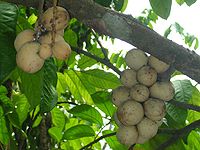Valencia (Negros Oriental)
| Municipality of Valencia (Luzurriaga) | ||
| Location of Valencia in the province of Negros Oriental | ||
|---|---|---|

|
||
| Basic data | ||
| Region : | Central Visayas | |
| Province : | Negros Oriental | |
| Barangays : | 24 | |
| District: | 3. District of Negros Oriental | |
| PSGC : | 074623000 | |
| Income class : | 1st income bracket | |
| Households : | 4860 May 1, 2000 census
|
|
| Population : | 34,852 August 1, 2015 census
|
|
| Population density : | 236.3 inhabitants per km² | |
| Area : | 147.49 km² | |
| Coordinates : | 9 ° 17 ′ N , 123 ° 15 ′ E | |
| Mayor : | Rodolfo V. Gonzales Jr. | |
| Website: | Valencia | |
| Geographical location in the Philippines | ||
|
|
||
Valencia (Luzurriaga) is a Filipino municipality in the Negros Oriental province . It has 34,852 inhabitants (August 1, 2015 census).
Valencia is 9 km west of Dumaguete City , the largest city and the capital of the province.
geography
The municipality of Valencia has an area of approximately 150 km² . Valencia is located 9 km west of the provincial capital Dumaguete City . 65% of the community area is classified as mountainous, the heights range from 200 m to 500 m above sea level . The average temperature is relatively low, especially in the higher elevations of the Cuernos de Negros volcanic mountains. Parts of the Balinsasayao Twin Lakes Natural Park are within the municipality's territory.
Barangays
Valencia is politically divided into 24 barangays .
|
|
history
The original name of Valencia was Ermita , which means something like "a remote place". Ermita served as a refuge from marauding Muslim pirates. In 1856 the place was renamed Nueva Valencia by the Spanish colonial rulers in honor of the parish priest Mathias Villamayor, who came from Valencia in Spain .
In 1920, the place to Don Carlos Luzuriaga, a delegate in the Philippine Legislature in was Luzuriaga renamed. He had promised the community leaders to work for the development of the place, but this promise was not fulfilled to satisfaction, which is why the old name Nueva Valencia was reintroduced in 1941 .
In 1948 the name Valencia was officially introduced under Mayor Rodolfo V. Gonzalez Sr., the part of the name "Nueva" was deleted.
politics
Rodolfo Gonzalez, Jr., who was re-elected in 2004 and 2007, has been mayor since 2001.
Culture and sights
The local saint of Valencia is Mary, mother of Jesus . In her honor there is a festival every year on October 12th. This day is an official and non-working holiday in Valencia.
economy
The economy of Valencia is largely based on agriculture. Main products are abaca , copra , corn , flowers, vegetables, root vegetables and exotic fruits such as lanzones and rambutan .
Valencia is the location of a geothermal power plant operated by the National Power Corporation and supplies Negros , Panay and parts of Cebu with electricity. The municipal government receives user fees, which it uses to subsidize electricity prices for the residents of Valencia.
Many Valencia residents work in the nearby city of Dumaguete City.
Tourist attractions include the Forest Camp, Casaroro Falls , the Filipino-American-Japanese Friendship Shrine , and the World War II Museum.


